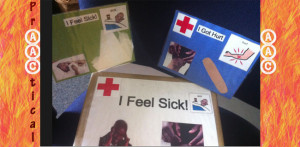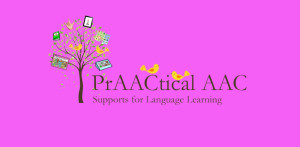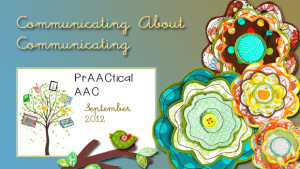September 26, 2012
by Carole Zangari -

Get ready, AAC lovers, AAC Awareness Month is coming! One of the most wonderful things about the AAC community is the pervasive sense of sharing and giving. When we told some of the people we know that PrAACtical AAC was planning a giveaway for AAC Awareness Month, they responded with an overwhelming level of generosity. So far, we have books, switches, software, apps, and a low tech SGD to give away from some of the companies whose logos are appear in his collage and more. What can you do to win some of these fabulous goodies? Help spread the word about what AAC is, who can benefit, and how to better implement it. We’ve started you off with some suggestions here: 50 PrAACtical Things to Do In Celebration of AAC Awareness Month. We’ll be sharing more information about how to enter to win some fabulous AAC-related goodies, but we’ll give... [Read More...]
Filed under: PrAACtical Thinking
Tagged With: AAC Awareness Month, free, Giveaway, resources
September 17, 2012
by Carole Zangari -

There are things no one likes to talk about. Serious things. Sensitive things. Nonetheless, everyone deserves the tools to be able to talk about whatever they want to share. The How It Is Project, by the UK-based Triangle organization, offers a set of free pictures developed so that everyone has access to images they can use to talk about their feelings, their rights, personal safety, personal care, and sexuality. We love how they developed the vocabulary list and symbols on the site with the help of children and youth with and without disabilities. You can download the document with images here.
Filed under: PrAACtical Thinking
Tagged With: advocacy, self-advocacy, symbol, vocabulary
September 16, 2012
by Carole Zangari -

We’re always looking for new ways to represent things visually. Today, we’re sharing an idea from Amy Laurent on helping children take turns. You can view a video explaining the strategy she uses and download the visual support here.
Filed under: PrAACtical Thinking
Tagged With: ASD, intervention, pragmatics, social skills, turn taking, visual supports
September 15, 2012
by Robin Parker -

We were looking over the great hospital resources from Patient Provider Communication Forum, Central Coast Children’s Foundation, Dr. Bronwyn Hemsley, and Widgit Software that Carole wrote about and realized that not everyone automatically knows how to talk about pain, illness and injury. We often need to teach the expression of these concepts. We use various types of modeling and create Boxes or Drawers that have items (i.e., bandaids, antiseptic, washcloth, ice buddy, etc) to ‘help with Cuts/Scrapes’ (or any other illness). We have had some fun and lots of practice using these apps to also help the learning process. 5 Apps To Learn and Practice Talking About Pain, Illness, & Injury Don’t forget to model, play, and use the apps often in the teaching process so when they are really needed you will see spontaneous communication and language. Toca Doctor– learning about injury and sickness through fun noncompetitive challenges that involve ‘healing’ the damaged part.... [Read More...]
Filed under: PrAACtical Thinking
Tagged With: Apps, illness, Injury, Medical Resources, pain, visual supports
September 14, 2012
by Carole Zangari -

We are so happy to share a link to downloadable resources that come from the collaborative effort of the Patient Provider Communication Forum, Central Coast Children’s Foundation, Dr. Bronwyn Hemsley, and Widgit Software. These research-based materials were developed to help improve communication in hospital settings. The link takes you to the Widgit Health site and is a set of cards with 26 key phrases for patients who use picture symbols to communicate. The cards are printable and available in 20 different languages. You can access those materials here.
Filed under: PrAACtical Thinking
Tagged With: advocacy, communication boards, download, hospital, Medical, resources
September 7, 2012
by Carole Zangari -

It’s been a depressing week for us. Too many exchanges with SLPs who should know how to ‘do’ this intervention and don’t. Too many conversations with parents who have not been able to access decent AAC services. Too many delays in getting devices in the hands of clients. We’ll get back to being positive and solution-oriented, but first we need to wallow in the misery of it a bit. The case for improved services to individuals with little or no functional speech is perhaps best made by those whose voices we cannot hear in a traditional sense. Below is a sampling of quotations from scholarly and personal writings of and by users of AAC. Michael Twice a week my academic pursuits were interrupted. I was sent out of the classroom and wheeled down to the other end of the building where I was put into a small, airless room to await... [Read More...]
Filed under: PrAACtical Thinking
Tagged With: advocacy, rant, transitions
September 5, 2012
by Robin Parker -

AAC Supports- Don’t Go ANYWHERE Without Them.. Access To AAC & Visual Supports Allows Students to: Let you know what they want Let you know nicely what they don’t want Answer class questions Ask a question Say ‘I don’t know’ Ask for help Tell you they are having fun Create a Sentence Argue Negotiate Say a line in a school play Say ‘here’ during attendance Tell what they did on the weekend Tell what they did over the summer Tell you what they want to do at home Tell you if they are happy Tell you if they are scared Tell you if they are frustrated Tell you about their family Tell you about their pets Say please Say their name Say hello to a person Tell you what they like to do Ask for more Tell you which color they want Ask for a break Tell you why they are... [Read More...]
Filed under: PrAACtical Thinking
Tagged With: Benefits AAC, Nice Things To Say
September 3, 2012
by Carole Zangari -

Last week I was talking to a bright, young professional who is starting her second year as a school-based SLP. She has a caseload of 60+ students, including a class of students who have significant communication impairments. When the conversation turned to building a support system for her students who use AAC, we talked about strategies for keeping all of the stakeholders in the loop. Here are some of the the things we touched on.
Filed under: PrAACtical Thinking
Tagged With: communication, families, home, schools, therapy, tips
September 2, 2012
by Robin Parker -

We have recently been surprised (ok, shocked) by the absence of communication supports in educational settings that are supposed to be supporting learners with significant communication challenges. To be even more specific and blunt, the students do not have functional spoken speech. They can’t speak to let you know: what they need, what they don’t need or want, how they feel, what they see, what interests them, what questions they have, what they like and don’t like, when they really reallywant something, etc., etc. etc. And, trust us, they do need to say all of these things. If you work with anyone who does not use spoken speech and we mean ANYONE, they deserve the basic right to communicate with you. Our PrAACtical AAC Absolute A’s: AAC displays need to be accessible ALLOVER. There is no special ‘communication time.’ Communication teaching is ALL the time in authentic situations.... [Read More...]
Filed under: PrAACtical Thinking
Tagged With: AAC Strategies
August 27, 2012
by Carole Zangari -

“How was school?” (Good) “What did you do?” (Nothing) This scenario plays out in many cars and kitchens in the after school hours and it can be hard to know who is more frustrated: the kids for being asked or the parents for not getting satisfactory answers. And still, we repeat the process day after day. Of course, we want to know the fine details of what happened and how our children felt, but in some cases, we’d settle for ANY school-related conversation at all. I’ll be the first to admit that it took me way too long to get the hang of how to get information about my children’s school days, and it seemed like just when I did, pow! They were pre-teens and then teenagers. New rule book. Here are some ‘lessons learned’ along the way about those afterschool conversations and some suggestions for parents of the kids... [Read More...]
Filed under: PrAACtical Thinking
Tagged With: families, home, implementation ideas, schools, visual supports









